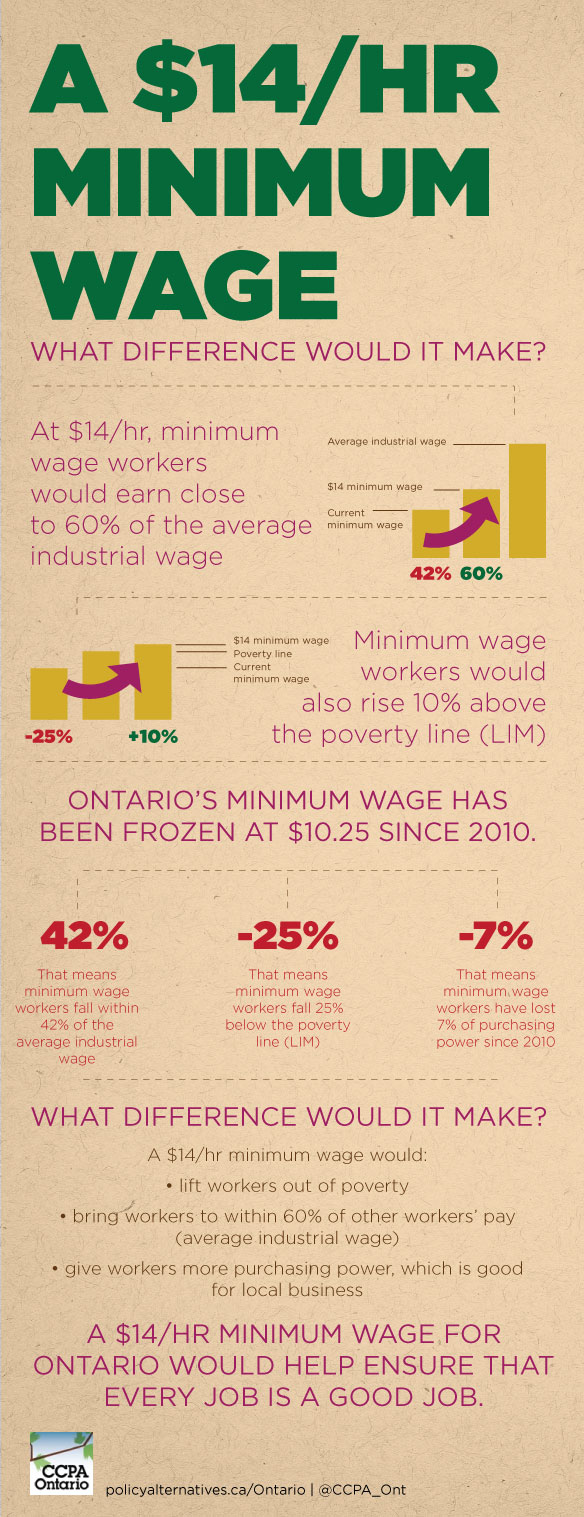It seems everywhere I turn people are talking income inequality. Whether it’s on the pages of the current Globe and Mail series, “The Wealth Paradox,” or in the Toronto-Centre by-election where both front-runners claim to be experts on the subject, the issue finally seems to be taking up space in the public consciousness.
But conversations don’t necessarily translate into the kind of political interventions needed to meaningfully reduce income inequality. What is actually being done to correct the growing gap between the rich and the rest of us right here in Ontario?
Many are watching closely as the government prepares to receive a report from its recently convened minimum wage panel — a panel that will recommend how to set and raise the province’s minimum wage. The CCPA Ontario recently made a submission to this panel, based on our report Making Every Job a Good Job.
A decent minimum wage is an important way to address income inequality. If we think of the minimum wage as the floor, ensuring that all full-time workers are afforded a minimum acceptable standard of living, then the minimum wage matters — a lot — to correct our course and reducing income inequality.
Ontario’s minimum wage has been frozen for three years. There is broad consensus that the minimum wage should be adjusted for inflation on a yearly basis. The debate differs widely, however, on which benchmark should be used to set the minimum wage, and how much a full-time, full-year worker should expect to earn for their labour. Everything from productivity, to measures of poverty, to average industrial wages is on the table. Through it all, one simple fact remains: by every measure, our current minimum wage falls short.
Currently a full-time, full-year minimum wage worker earns 25 per cent less than Ontario’s poverty line, or Low Income Measure (LIM), which currently sits at $23,690 for a single individual. A full-time, full-year minimum wage worker earns only $17,937.50 (for 35 hours a week, 50 weeks a year). By contrast, in the mid-1970s minimum wage workers earned at least 1 per cent above the poverty line.
Since 2010, the Consumer Price Index has increased by 7 per cent. In other words, minimum wage workers have lost 7 per cent of their purchasing power and it will continue to erode the longer the minimum wage remains unchanged.
One final lens through which to view the problem: Ontario’s minimum wage sits at only 42 per cent of the average industrial wage. A 60 per cent target would bring the minimum wage to $14.53. If pursued today, it would bring Ontario’s minimum wage in line with European policies and would track closely with the minimum wages of France, New Zealand, Australia, Belgium and Ireland.
Taking all of this into account, it’s hard to imagine a measure that would justify the status quo.
An increase to the minimum wage, on the other hand, can have numerous positive spillover effects.
A robust minimum wage:
Ensures that consumers have the purchasing power necessary to participate in our economy. It is commonly understood that low-income earners spend more of their money locally than those at the upper end of the income spectrum. At a time when government is relying on consumer spending to drive economic growth, it would ensure that all consumers have the purchasing power to make it happen.
It would be good for workers. More money in workers’ pockets would mean less stress at home and a better chance of meeting their household needs. More money could also mean more time to spend with family as workers won’t have to work quite so many hours to make ends meet.
It is good for productivity. Higher wages improve worker well-being, decrease absenteeism and improve focus on the job.
It gives employers incentive to invest in labour-enhancing capital to improve efficiency. Higher wages can lead to important innovations and the higher-skilled employment opportunities that so many low-wage workers desire.
It can have a positive impact on a company’s bottom line. A recent study of retail operations in the United States found that companies with well-paid and well-trained employees, such as Costco, have higher sales, higher rates of customer satisfaction and overall higher profits than companies that treat their employees as a costly drain on profits.
It will help reduce income disparity. By boosting the incomes of workers at the bottom of the spectrum, the share of total income received by the bottom two deciles would increase. Reducing inequality is an important public policy goal that must be tackled by all facets of society. Paying better wages is one area where business can play an important role.
It’s clear that more Ontarians are talking and thinking about income inequality. The Minimum Wage Panel and the Wynne government, which will soon receive the panel’s advice, have an opportunity to help shrink the growing income gap or let it continue to widen. The need for action, and the positive impact that would result from a higher minimum wage and regularly scheduled increases, is clear. The only question that remains is how bold they will choose to be?




